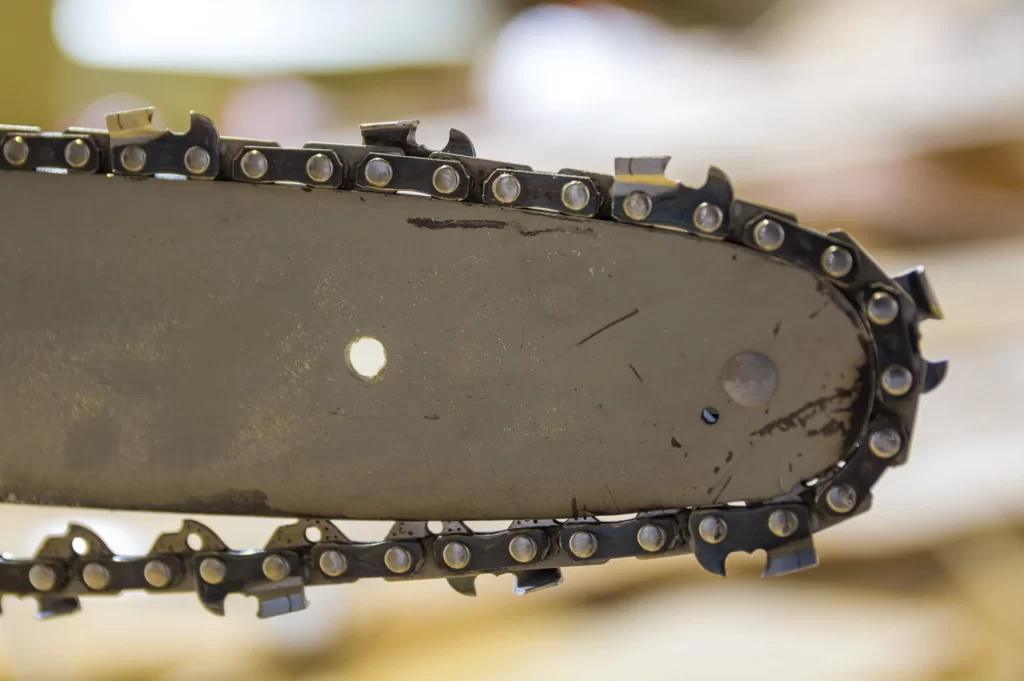Measuring a chainsaw bar is a straightforward process and is important when you need to replace the bar or select the right chain for your chainsaw.
To measure a chainsaw bar length, follow these steps:
First, ensure safety by turning off the chainsaw and disconnecting the spark plug. Locate the bar, which is the elongated metal piece opposite the chain.
Measure from the very tip of the bar to where it enters the chainsaw’s housing using a measuring tape or ruler, noting the length in inches or centimeters.
Chainsaw bar lengths can vary from 10 to 36 inches or more, so consult your user manual or manufacturer’s specifications if you’re uncertain. Using the correct bar length is crucial for efficient and safe cutting, as an incorrect length can strain the chainsaw’s engine and pose safety risks.
What Are the Essential Tools and Equipment Need?

To accurately measure your chainsaw bar, you’ll need a few essential tools and equipment that ensure precision and ease of use.
List of necessary tools and equipment
Measuring Tape or Ruler: A measuring tape or ruler is essential for measuring the length of the chainsaw bar accurately. Moreover, it provides precise measurements in inches or centimeters.
Chainsaw Wrench: A chainsaw wrench is required to safely remove the chainsaw’s chain and bar. In addition, it typically has a combination of socket and screwdriver bits to fit various chainsaw components.
Vernier Caliper: A vernier caliper is a precise measuring instrument used to measure the pitch and gauge of the chainsaw chain. It provides accurate readings in millimeters or inches.
Flat File: A flat file is used for sharpening the chainsaw chain, which can affect the chain’s performance and the measurement process. Hence, a sharp chain ensures an accurate measurement.
Cleaning Brush: Keeping your chainsaw and bar clean is crucial for accurate measurements. A cleaning brush helps remove debris and sawdust from the bar’s groove.
Safety Gear: This includes safety glasses, gloves, and hearing protection. While not tools for measurement, safety gear is vital when working with chainsaws to protect against potential hazards.
How to Measure ChainSaw Bar Step-by-Step?
Measuring your chainsaw bar step-by-step is a straightforward process that ensures the right fit for your cutting needs.
Measure the length of the chainsaw bar
To measure your chainsaw’s entire length safely and accurately, follow these straightforward steps.
Firstly, make sure the chainsaw is turned off, and engage the chain brake for safety. Then, grab a measuring tape or ruler and measure from the tip of the chainsaw bar. Where it comes out of the casing, to either the point where it enters the chainsaw’s housing or the center of the sprocket, following the manufacturer’s instructions.
Moreover, keep your measurement in a straight line, following the bar’s curve, and jot down the result in inches or centimeters. Remember, precision matters here because it dictates the size of replacement bars and accessories that will fit your chainsaw correctly.
Determine the pitch of the chainsaw chain
Describe how to count the drive links or measure the pitch: Count the number of drive links on the chainsaw chain. Drive links are the protruding parts of the chain that sit in the groove of the bar.
Alternatively, you can measure the distance between three consecutive rivets and divide that measurement by two. This will give you the pitch measurement.
Furthermore, the pitch measurement is typically expressed in millimeters or inches and is crucial for selecting the right replacement chain.
Measure the gauge of the chainsaw chain
Explain the method for measuring chain gauge: The chain gauge refers to the thickness of the drive links on the chainsaw chain. Measure the thickness of the drive link using a vernier caliper.
Common chain gauges include 0.050 inches (1.27 mm) and 0.063 inches (1.6 mm). In addition, ensure accuracy when measuring the gauge, as it must match the specifications of the bar’s groove to ensure proper fit and operation.
Calculating the Effective Cutting Length
How to factor in the pitch and gauge measurements:
To calculate the effective cutting length of the chainsaw bar, subtract approximately 2 inches (5 cm) from the measured length. This accounts for the portion of the bar that remains inside the chainsaw’s housing.
In addition, the effective cutting length is essential because it determines the maximum width of the wood you can cut with the chainsaw. It ensures you don’t overload the chainsaw or cause it to bind during operation.
Final Words
In conclusion, mastering the art of measuring a chainsaw bar is a fundamental skill for any chainsaw operator. A precise measurement of the chainsaw bar’s length, coupled with an accurate assessment of the chain’s pitch and gauge, is paramount to ensuring safe and efficient cutting operations.
Additionally, discussed the calculation of the effective cutting length, a critical factor for determining the size of wood you can cut with your chainsaw safely.
Furthermore, highlighted the significance of compatibility between the chainsaw bar and the saw itself, underscoring the importance of adhering to manufacturer specifications.
